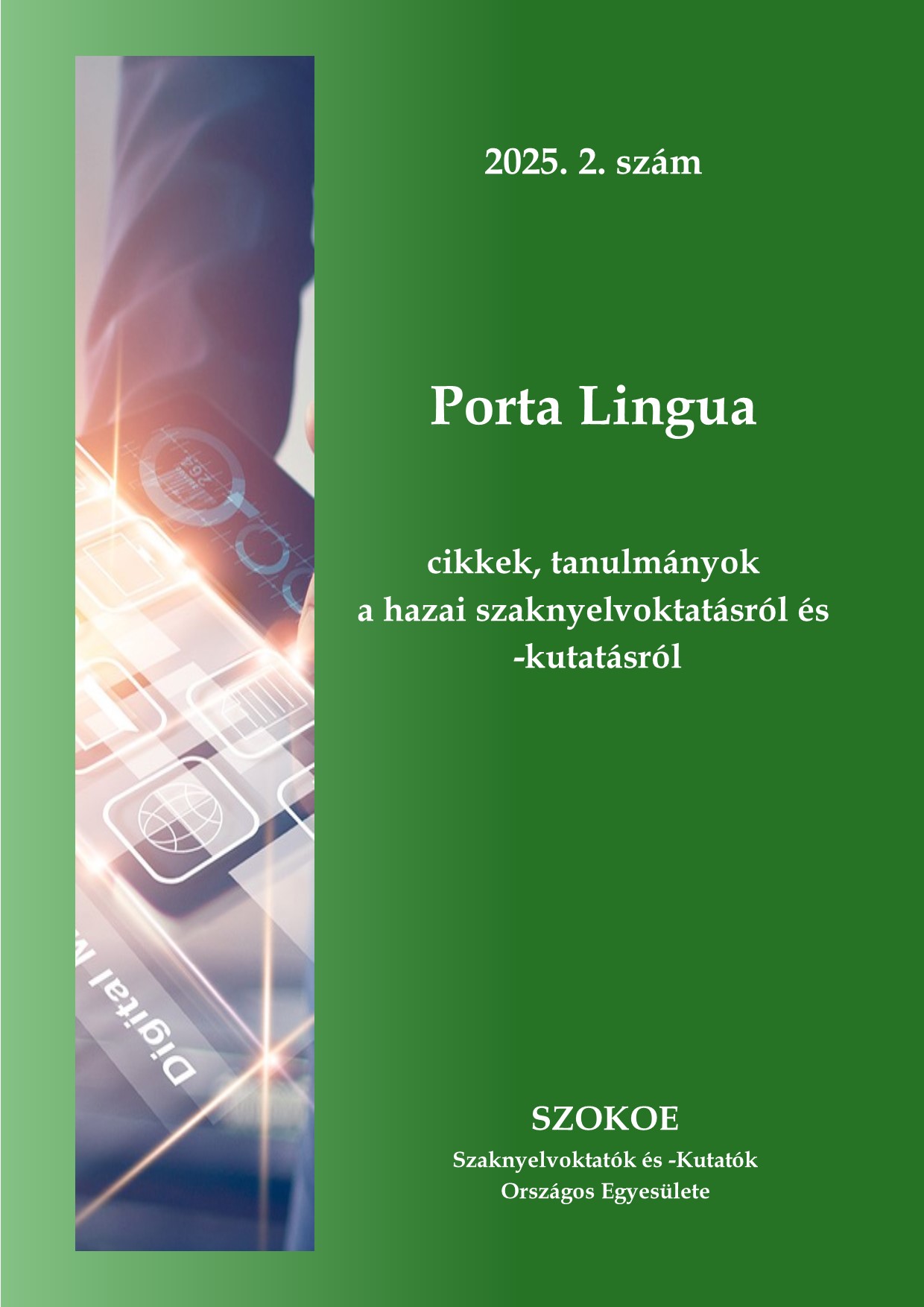The multiple functions of the word ‘one’ in research articles
Absztrakt
Ezt a korpuszvizsgálatot szerzői kérdések inspirálták, amelyek a ’one’ szó tudományos publikációkban történő megfelelő alkalmazására vonatkoztak helyettesítő névmásként és általános névmásként való használat esetén. Kerülik-e ezek használatát a szerzők a napjainkban publikált tudományos cikkekben? Milyen szerepet játszik a ’one’ szó a folyóiratcikkekben? A jelen tanulmány ezekre a kérdésekre keresi a választ 15 cikkalapján, amelyek az „English for Specific Purposes” című folyóiratban jelentek meg a közelmúltban. Az eredmények azt mutatják, hogy a ’one’ szó számnévként való használata a leggyakoribb; ebben a formában minden cikkben előfordul a szövegtörzsben, és számos alkalommal szerepet játszik az információk rendszerezésében. Korábban megjelenő főnév helyettesítőjeként a ’one’ szó tíz cikkben szerepel kötőelemként, leggyakrabban az eredmények és a tárgyalás részben, míg az általános névmásként funkcionáló ’one’ – amely öt cikkben jelent meg – inkább inkluzív, mint személytelen referenciaként jelent meg. A kérdéseket érdemes tovább vizsgálni egy nagyobb korpuszon.
Hivatkozások
Adorján, M. (2015): Lexical Repetition in Academic Discourse: A Computer-aided Study of the Text-organizing Role of Repetition. PhD thesis, Doctoral School of Education, Eötvös Loránd University: Budapest, Hungary
Biber, D. – Johansson, S. – Leech, G. – Conrad, S. – Finegan, E. (1999): Longman Grammar of Spoken and Written English. Pearson Education: Harlow, England
Bondi, M. – Nocella, J. J. (2023): Academic writing conventions in English-medium linguistics journals in Italy: Continuity and change over the last 30 years. Token: A Journal of English Linguistics. 16. 55-87 https://doi.org/10.25951/11258
Cabrejas, M. M. (2022): Cohesive devices on the abstracts of select research articles presented in the International Academic Forum (AIFOR): A discourse analysis. British Journal of Multidisciplinary and Advanced Studies: Education, Learning, Training & Development. 3/1. 22-41 https://doi.org/10.37745/bjmas.2022.0017
Dontcheva-Navratilova, O. (2023): Academic writing conventions in Czech English-medium linguistics journals: Continuity and change over the last 30 years. Token: A Journal of English Linguistics. 16. 25-54. https://doi.org/10.25951/11258
Halliday, M. A. K. – Hasan, R. (1976): Cohesion in English. Routledge: London.
Hardjanto, T. D. – Roselani, N. G. A. (2022): Objectifying science: Impersonalization in English research articles from different disciplines. Theory and Practice in Language Studies. 12/10. 2072-2083. https://doi.org/10.17507/tpls.1210.14
Hyland, K. (2000): Disciplinary Discourses: Social Interactions in Academic Writing. Longman: Harlow, England.
Hyland, K. (2001): Bringing in the reader: Addressee features in academic articles. Written Communication. 18/4. 549-574. https://doi.org/10.1177/0741088301018004005
Hyland, K. (2002): Options of identity in academic writing. ELT Journal. 56/4. 351-358. https://doi.org/10.1093/elt/56.4.351
Károly, K. (2002): Lexical Repetition in Text. Peter Lang: Frankfurt am Main
Kuo, C.-H. (1999): The use of personal pronouns: Role relationships in scientific journal articles. English for Specific Purposes. 18/ 2. 121–138. https://doi.org/10.1016/S0889-4906(97)00058-6
Pearson, H. (2023): Impersonal pronouns and first-person perspective. Annual Review of Linguistics. 9. 293-311. https://doi.org/10.1146/annurev-linguistics-031120-102547
Quirk, R. – Greenbaum, S. – Leech, G. – Svartvik, J. (1985): A Comprehensive Grammar of the English Language. Pearson Longman: London.
Swales, J. M. (1990): Genre Analysis: English in Academic and Research Settings. Cambridge University Press: Cambridge, England
Wallwork, A. (2013): English for Academic Research: Grammar Exercises. Springer Science+Business Media: New York, NY
Wang, S.P. – Tseng, W.T. – Johanson, R. (2021): To we or not to we: Corpus-based research on first-person pronoun use in abstracts and conclusions. SAGE Open. 11/2. 1–18. https://doi.org/10.1177/21582440211008893
Zapletalová, G. (2009): Personal pronouns and writer identity as a type of communication strategy in academic texts. Ostrava Journal of English Philology. 1. 120-129
Internet sources
APA style writing principles. American Psychological Association. https://apastyle.apa.org/instructional-aids/writing-principles.pdf
Griffies, S.M. – Perrie, W.A. – Hull, G. (2013): Elements of style for writing scientific journal articles. Researcher Academy, Elsevier. https://researcheracademy.elsevier.com/uploads/2017-11/Elements%20of%20Style%20for%20Writing.pdf
Guide for authors. English for Specific Purposes, Elsevier. https://www.sciencedirect.com/journal/english-for-specific-purposes/publish/guide-for-authors
Insights. English for Specific Purposes, Elsevier. https://www.sciencedirect.com/journal/english-for-specific-purposes/about/insights
Scimago Journal Ranking. Journal of English for Specific Purposes. https://www.scimagojr.com/journalsearch.php?q=20598&tip=sid
Tan, E. 2019. The power of synonyms: the good, the bad, and the in-between. Blog, June 19. Writing and Communication Centre, University of Waterloo. https://uwaterloo.ca/writing-and-communication-centre/blog/power-synonyms-good-bad-and-between
Word choice. Writing Center, University of North Carolina at Chapel Hill. https://writingcenter.unc.edu/tips-and-tools/word-choice/



